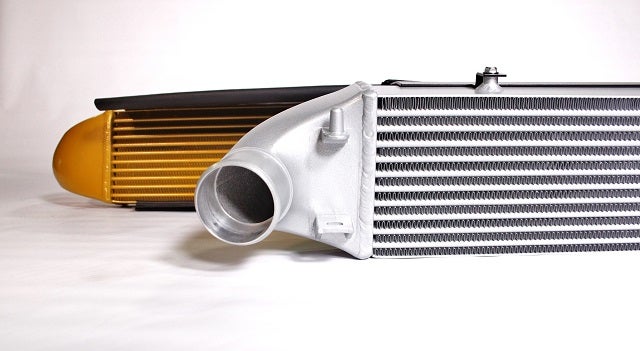
We Rate The 4 Types of Intercooler End Tanks And Help You choose Which is best for you
So, you're ready to pull the trigger and get an intercooler, but all of the options available are overwhelming. How do you choose? Looking at the end tanks of an intercooler can be a great place to start. Once you determine the type of end tank that fits your needs, you can narrow down the endless options making selection much more straightforward.
There can be several failures caused by poor end-tank design, so we want to make sure that you have the information you need to make the right decision when choosing your intercooler. Selecting the correct type of end tank can help shape the long-term reliability of your upgrade and can also play a significant role in actual airflow through your core. If your end tank design is not efficient at moving the airflow your vehicle generates, you won't be able to take full advantage of that awesome intercooler you selected.
Plastic
Plastic end tanks are often found on stock vehicles and are usually the choice of manufacturers when they include an intercooler on a vehicle. For stock vehicles, the main enemy of plastic end tanks are rocks and road debris that can cause damage. You are likely reading this article because you want to go beyond stock, though, and failures are much more common as more boost is pushed through the intercooler system.
As you can imagine, one of the downfalls of this option is that plastic will begin to weaken over time. Constant variations of temperature and pressure affect the integrity of plastic and lead to eventual failure. This normally occurs during a high-boost pull, and you're left with a cracked or shattered end tank.
Our engineers tested the pressure capacity of a plastic end-tank equipped intercooler, and the result was a nice explosion. Check out the video below!
Plastic end tanks are connected to aluminum cores with crimp connections. Within the crimp connection is a rubber gasket, which provides a seal between the aluminum core and the end tank. The crimps fold over on the tank to hold these two components firmly together. To add to the list of possible failures, the crimp connections that hold the plastic to your core can also spread with constant exposure to high boost and will eventually cause a leak within your system.
Leaking connections, if small, can go undetected and result in additional wear on your turbocharger and engine. If you have an intercooler with plastic tanks, it may be wise to examine it the next time you perform vehicle maintenance. Leaking areas can usually be identified by oil seepage.
-
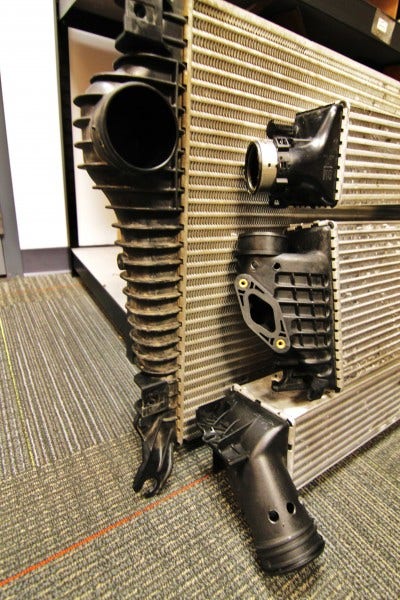
Plastic intercooler end tanks -

Plastic intercooler end tank
So why even make plastic end tanks? A plastic end tank at a mass-produced level is far cheaper and lighter than all-aluminum options. Automotive manufacturers are seeking both low cost and reduced weight for just about all components on their vehicles which explains why nearly all modern stock and factory vehicles are equipped with plastic tanks.
We give plastic end tanks a 2.5/5. While this is an inexpensive option for OEM manufacturers, plastic does not stand the test of time, and there are many possible failure points, especially when you're modifying your vehicle.
Plastic End Tank Rating: 2.5/5
Stamped
Stamped aluminum end tanks are a bit of a hybrid and incorporate a lower cost for large scale manufacturing with the added durability of a one-piece design. These tanks can be found on older turbocharged vehicles, such as the second-generation Cummins and Mitsubishi Evolution, and are typically welded to the actual core.
Intercoolers with stamped end tanks can easily handle high boost pressures; however, they are usually paired to a standard tube-and-fin core, while a bar-and-plate core is usually preferred for improved performance. Stamped tanks are durable and flow reasonably well, and they are far stronger than plastic counterparts that eventually replaced them. However, stamped aluminum end tanks are not a common option in the OEM or aftermarket world.

We gave stamped intercooler end tanks a 3/5 because they aren't a readily available option on the market and you'll likely only see these types of intercoolers on older models of vehicles. That being said, they are more reliable than plastic and have slightly better aesthetic appeal.
Stamped End Tank Rating: 3/5
Cut-and-Weld Aluminum
-
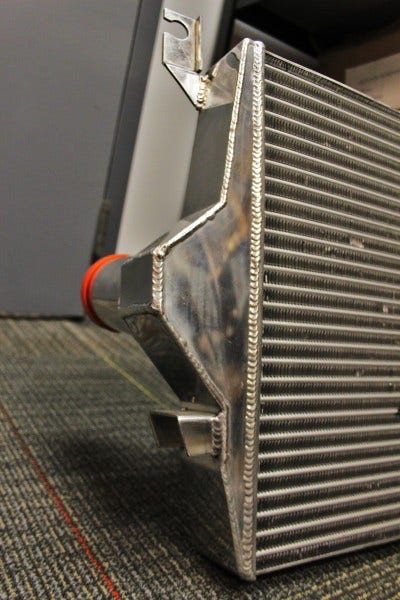
Cut-and-weld intercooler end tanks -
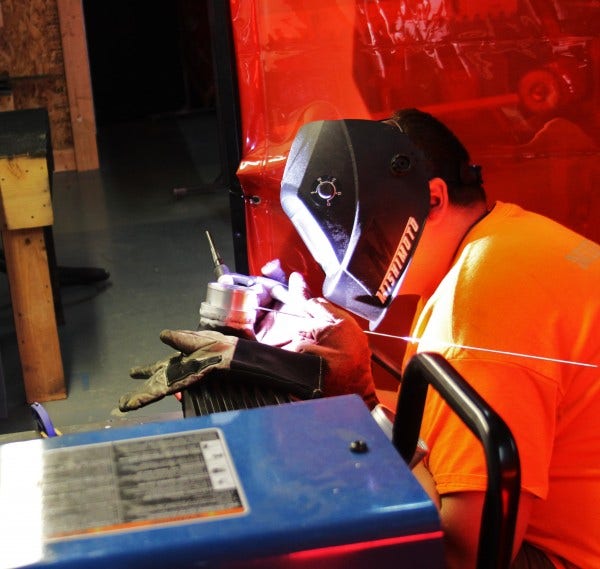
Cut-and-welded intercooler end tanks are a great option for an upgrade because they offer a high level of customization and look much better than plastic. By using aluminum and welding this to the core, you eliminate the failure points associated with plastic end tanks. However, these tanks are typically constructed from numerous pieces of aluminum, which increases the number of potential failure points if not welded properly. Precision welding, testing, and efficient quality control processes are necessary to avoid defects with such a design. Typically, a well-manufactured piece will provide fantastic durability and should withstand just about any level of boost you throw at it.
The level of customization that comes with cut-and-welded end tanks helps heavy modifiers push the limits by allowing them to create larger intercoolers and decide inlet and outlet locations. Check out our intercooler cores here if you are interested in constructing your very own cut-and-weld intercooler.

There is a downside to this style. Because this tank is constructed from pieces of flat aluminum, it does not allow for much in terms of designing the internal surface to smooth airflow. This means that smoothing the airflow is either quite a challenge or not possible at all. Why do we care about smooth airflow, you ask? Continue reading, and you'll see why.
To our eyes, a cut-and-weld intercooler tank is shadowed only by a cast-aluminum tank. Because of the opportunity to customize the shape of your intercooler, we did extend a .5 to this rating.
Cut-And-Welded End Tank Rating: 4.5/5
Cast-Aluminum

Cast- aluminum end tanks have a one-piece aluminum design that is TIG-welded to the core of the cooler providing reliability, flow, and aesthetic appeal.
This design eliminates failure points from crimp connections, poor welds on a cut-and-weld unit, and blown-out plastic tanks. The thickness of an end tank can vary depending on the pressure requirements, so our engineers rigorously test our products to make sure you can run any boost pressure without concern about destroying the tank. If you can manage to do so, however, please send us pictures.
Along with more robust construction, this tank design allows our engineers to optimize airflow to use the entire core. For instance, our engineers use CFD software to ensure the design of the end tank provides flow to the entire length of the core for optimal cooling. This is especially important for intercoolers on the taller side. Our engineers can even cast air diverters into the internal portion of the tank to push airflow to portions of the core where airflow would not otherwise reach.
-
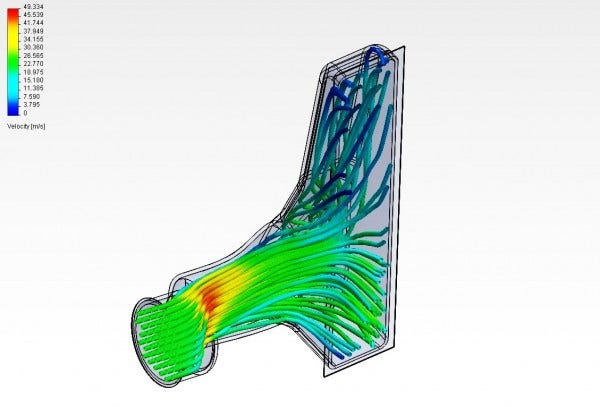
Intercooler CFD analysis example shows where airflow is being directed. -
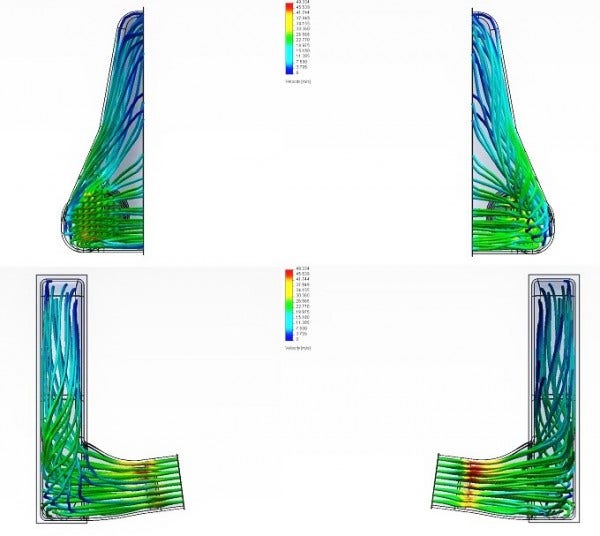
Intercooler CFD analysis example
-

Cast intercooler end tank with air diverters -

Cast intercooler end tank with air diverters
All of this innovation aids in the intercooler's ability to transfer heat. Even if the impact is only the drop of a few degrees in intake temperatures, we find value in spending the time to create a cooler that we know is our best work.
We gave the cast aluminum end tank such a high rating because it is the ideal choice from both an engineering as well as from a consumer decision-making standpoint. You get a high-quality product that not only has limited failures but also has the bonus of optimal airflow and looks fantastic.
Cast-Aluminum End Tank Rating: 5/5




